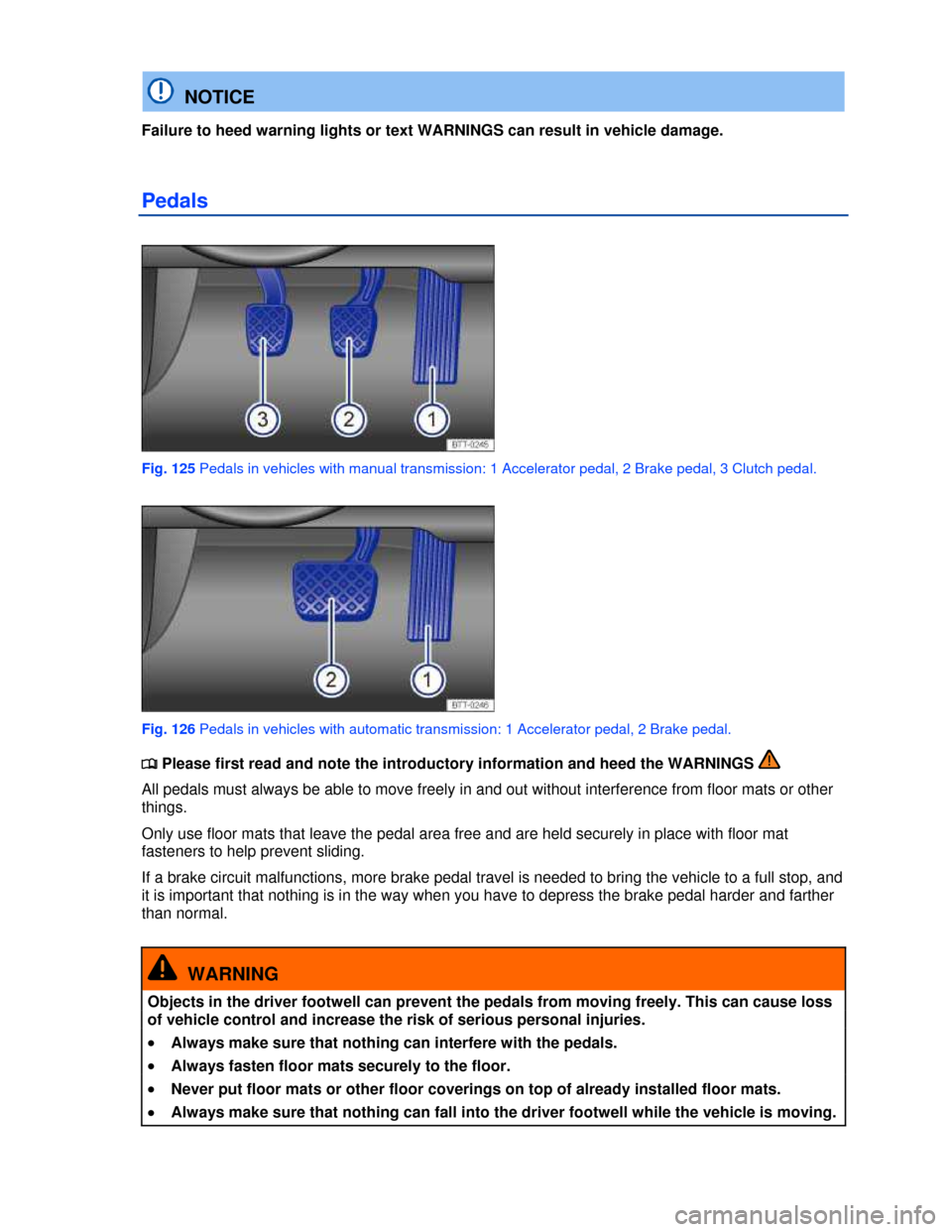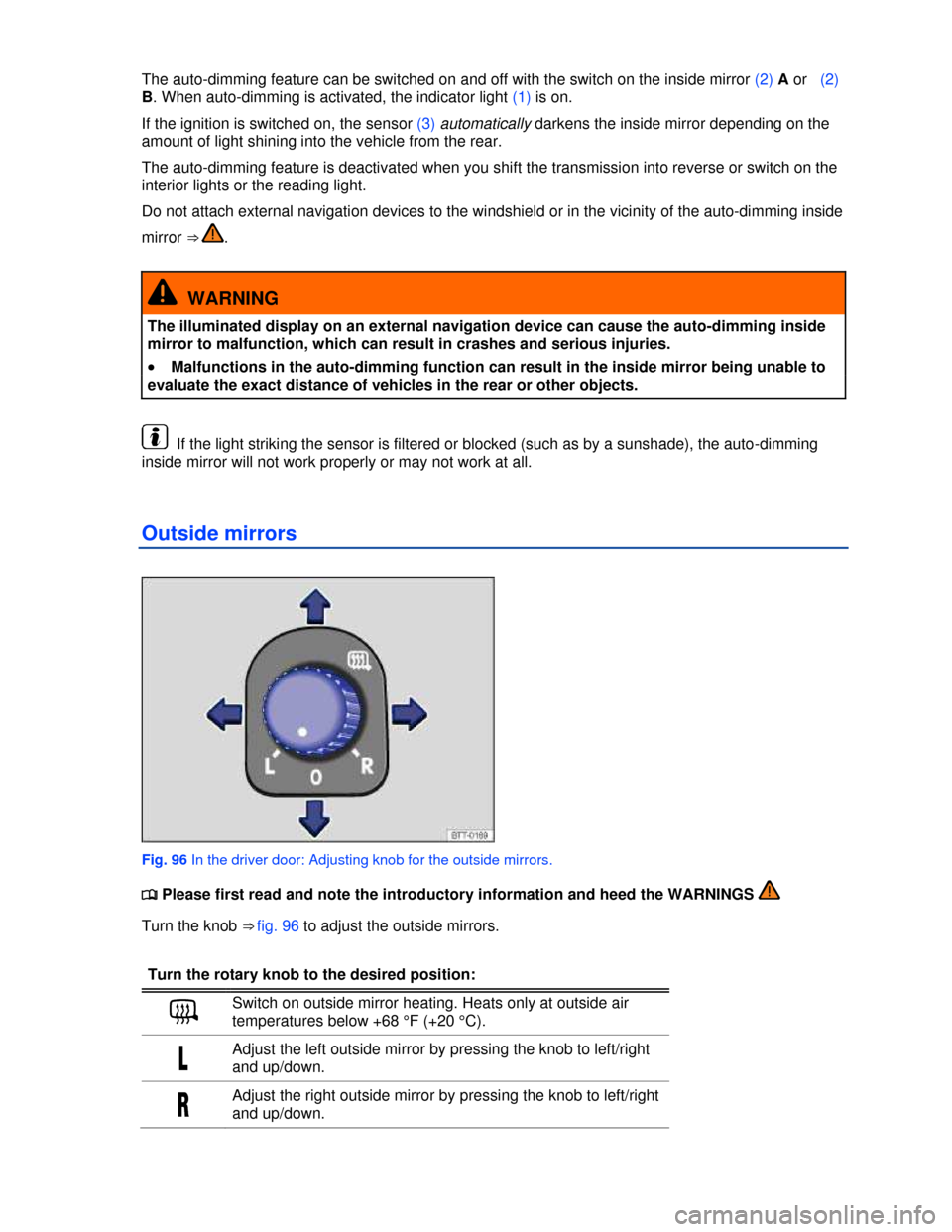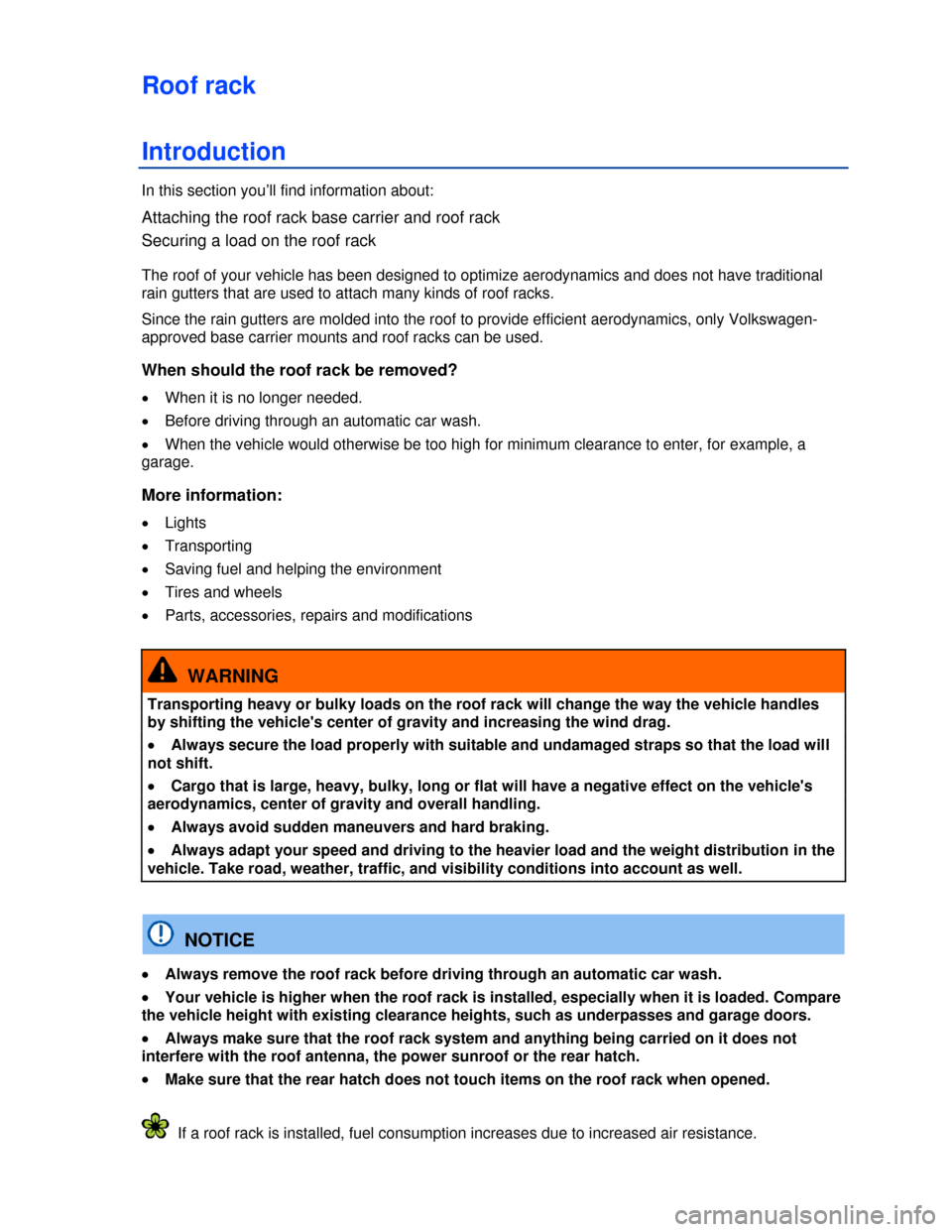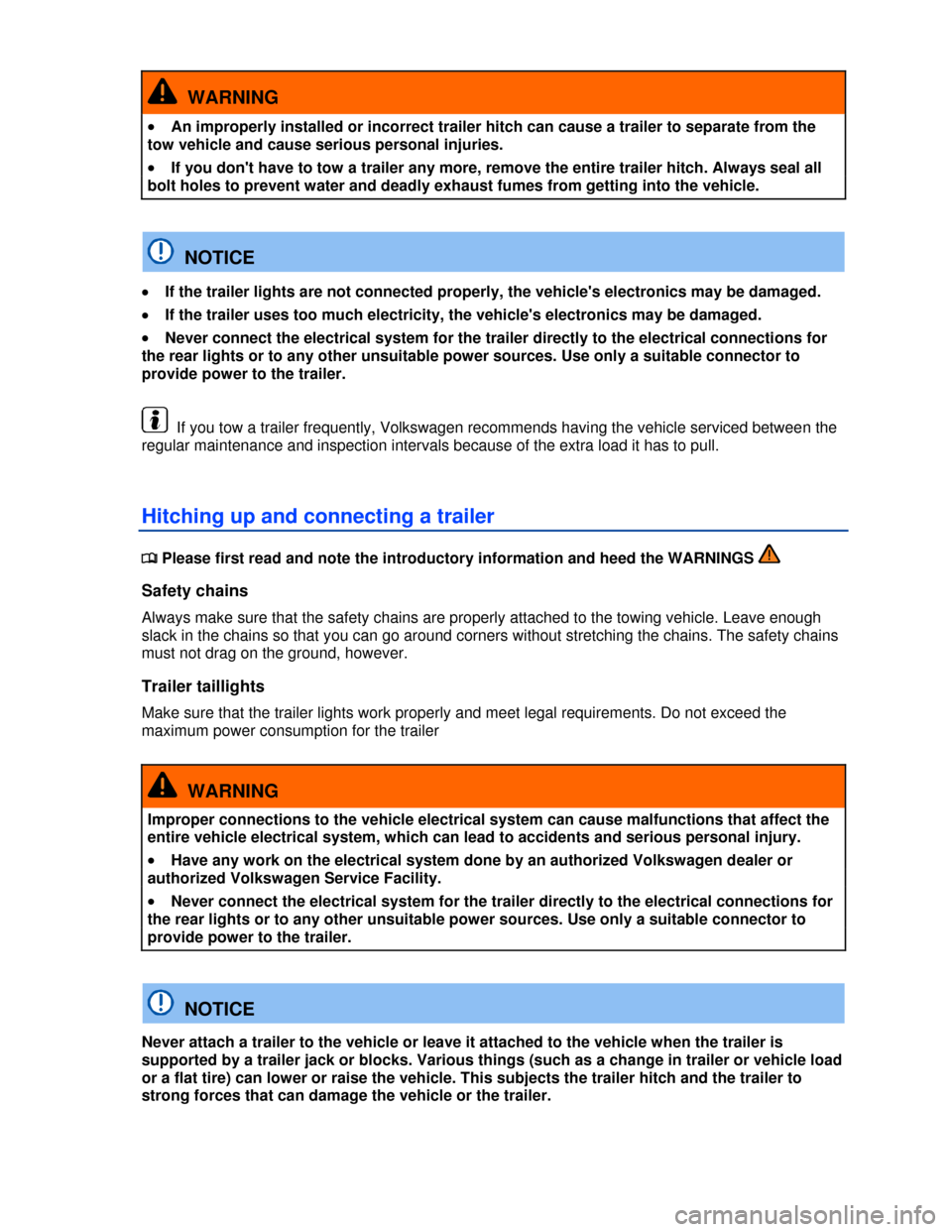2013 VOLKSWAGEN GOLF GTI Warning lights
[x] Cancel search: Warning lightsPage 123 of 319

NOTICE
Failure to heed warning lights or text WARNINGS can result in vehicle damage.
Pedals
Fig. 125 Pedals in vehicles with manual transmission: 1 Accelerator pedal, 2 Brake pedal, 3 Clutch pedal.
Fig. 126 Pedals in vehicles with automatic transmission: 1 Accelerator pedal, 2 Brake pedal.
�
Page 134 of 319

The auto-dimming feature can be switched on and off with the switch on the inside mirror (2) A or (2)
B. When auto-dimming is activated, the indicator light (1) is on.
If the ignition is switched on, the sensor (3) automatically darkens the inside mirror depending on the
amount of light shining into the vehicle from the rear.
The auto-dimming feature is deactivated when you shift the transmission into reverse or switch on the
interior lights or the reading light.
Do not attach external navigation devices to the windshield or in the vicinity of the auto-dimming inside
mirror ⇒ .
WARNING
The illuminated display on an external navigation device can cause the auto-dimming inside
mirror to malfunction, which can result in crashes and serious injuries.
�x Malfunctions in the auto-dimming function can result in the inside mirror being unable to
evaluate the exact distance of vehicles in the rear or other objects.
If the light striking the sensor is filtered or blocked (such as by a sunshade), the auto-dimming
inside mirror will not work properly or may not work at all.
Outside mirrors
Fig. 96 In the driver door: Adjusting knob for the outside mirrors.
�
Page 136 of 319

Driving tips
Introduction
In this section you’ll find information about:
Stowing luggage
Driving with an open rear hatch
Driving a loaded vehicle
Weights and axle weights
Always stow heavy objects in the luggage compartment and make sure that the rear seat backrests
are securely latched. Always use the tie-downs in the luggage compartment and secure the objects
with suitable straps. Never overload the vehicle. Remember that the vehicle load, as well as how it is
distributed, can affect vehicle handling and braking ⇒ .
More information:
�x Rear hatch
�x Folding the passenger seat backrest forward
�x Lights
�x Luggage compartment
�x Roof rack
�x Trailer towing
�x Tires and wheels
WARNING
Unsecured or incorrectly stowed items can fly through the vehicle, causing serious personal
injury during hard braking or sharp steering or in an accident. Loose items can also be struck
and thrown through the passenger compartment by the front airbags if they inflate. To help
reduce the risk of serious personal injury:
�x Always stow all objects securely in the vehicle.
�x Always keep storage compartments closed while driving.
�x Do not stow hard, heavy, or sharp objects in open bins in the vehicle or on top of the
instrument panel.
�x Remove hard, heavy, and sharp objects from clothing and bags in the vehicle interior and
stow securely. Always put heavy items in the luggage compartment.
�x Always secure objects in the passenger compartment properly with suitable straps so that
they cannot move into the deployment area of a side or front airbag during braking, in a
sudden maneuver, or in a collision.
�x Always make sure that there is nothing on the front passenger seat when the backrest is
folded forward. When the backrest is folded forward, even light objects could be pushed into
the seat cushion and cause the weight-sensing mat in the seat to register enough weight to
turn the airbag on
�x Always make sure that the PASSENGER AIR BAG OFF 9 light is on and stays on whenever
the backrest of the front passenger seat is folded forward
�x Passengers must never ride in an incorrect seating position because objects are being
transported in the vehicle.
�x Never let anybody sit in a seat that is blocked by objects being carried in the vehicle.
Page 141 of 319

Luggage compartment
Introduction
In this section you’ll find information about:
Folding the rear seat backrest forward and back into place
Luggage compartment cover
Luggage compartment pass-through
Tie-downs
Shopping bag hooks
Always stow heavy objects in the luggage compartment and make sure that the rear seat backrests
are securely latched in their upright position. Always secure objects to the tie-downs with suitable
straps. Never overload the vehicle. Remember that the vehicle load, as well as how it is distributed,
can affect vehicle handling and braking ⇒ .
More information:
�x Safety belts
�x Airbag system
�x Lights
�x Transporting
�x Trailer towing
�x Tires and wheels
WARNING
An open or unlocked luggage compartment poses special risks for children.
�x Close and lock the rear hatch and all doors when the vehicle is not in use. First, make
certain that no one is left inside.
�x Never leave your vehicle unattended or let children play around the vehicle, especially
with the rear hatch left open. A child could crawl into the vehicle and pull the hatch shut,
becoming trapped and unable to get out. This could cause severe or fatal injuries.
�x A closed vehicle can become very hot or very cold, depending on the season.
Temperatures can quickly reach levels that can cause unconsciousness or death, particularly
to small children.
�x Never let children play in or around the vehicle.
�x Never let anyone ride in the luggage compartment.
Page 150 of 319

Roof rack
Introduction
In this section you’ll find information about:
Attaching the roof rack base carrier and roof rack
Securing a load on the roof rack
The roof of your vehicle has been designed to optimize aerodynamics and does not have traditional
rain gutters that are used to attach many kinds of roof racks.
Since the rain gutters are molded into the roof to provide efficient aerodynamics, only Volkswagen-
approved base carrier mounts and roof racks can be used.
When should the roof rack be removed?
�x When it is no longer needed.
�x Before driving through an automatic car wash.
�x When the vehicle would otherwise be too high for minimum clearance to enter, for example, a
garage.
More information:
�x Lights
�x Transporting
�x Saving fuel and helping the environment
�x Tires and wheels
�x Parts, accessories, repairs and modifications
WARNING
Transporting heavy or bulky loads on the roof rack will change the way the vehicle handles
by shifting the vehicle's center of gravity and increasing the wind drag.
�x Always secure the load properly with suitable and undamaged straps so that the load will
not shift.
�x Cargo that is large, heavy, bulky, long or flat will have a negative effect on the vehicle's
aerodynamics, center of gravity and overall handling.
�x Always avoid sudden maneuvers and hard braking.
�x Always adapt your speed and driving to the heavier load and the weight distribution in the
vehicle. Take road, weather, traffic, and visibility conditions into account as well.
NOTICE
�x Always remove the roof rack before driving through an automatic car wash.
�x Your vehicle is higher when the roof rack is installed, especially when it is loaded. Compare
the vehicle height with existing clearance heights, such as underpasses and garage doors.
�x Always make sure that the roof rack system and anything being carried on it does not
interfere with the roof antenna, the power sunroof or the rear hatch.
�x Make sure that the rear hatch does not touch items on the roof rack when opened.
If a roof rack is installed, fuel consumption increases due to increased air resistance.
Page 153 of 319

Trailer towing
Introduction
In this section you’ll find information about:
Technical requirements
Hitching up and connecting a trailer
Loading the trailer
Driving with a trailer
Ball mount
Retrofitting a trailer hitch
Maximum permissible trailer weight
Obey country-specific requirements about trailer towing and trailer hitches.
Volkswagen does not recommend installing a trailer hitch on your vehicle. Your Volkswagen was
mainly designed for carrying passengers. If you plan to tow a trailer, please remember your vehicle will
be performing a job for which it was not primarily intended. The additional load will affect durability,
handling, fuel economy, and performance, and may require the vehicle to be serviced more often.
Trailer towing not only places more stress on the vehicle, it calls for more concentration from the
driver. Always follow the operating and driving instructions given, and use common sense.
Under winter conditions, install winter tires on the vehicle and the trailer.
Tongue weight
The maximum permissible trailer tongue weight exerted on the ball mount must not exceed 200 lbs
(91 kg).
More information:
�x Power locking and closing system
�x Anti-theft alarm system
�x Lights and vision
�x Braking, stopping, and parking
�x Saving fuel and helping the environment
�x Starting assistance systems
�x Tires and wheels
�x Parts, accessories, repairs and modifications
WARNING
Riding in a trailer is dangerous and may be illegal.
Page 156 of 319

WARNING
�x An improperly installed or incorrect trailer hitch can cause a trailer to separate from the
tow vehicle and cause serious personal injuries.
�x If you don't have to tow a trailer any more, remove the entire trailer hitch. Always seal all
bolt holes to prevent water and deadly exhaust fumes from getting into the vehicle.
NOTICE
�x If the trailer lights are not connected properly, the vehicle's electronics may be damaged.
�x If the trailer uses too much electricity, the vehicle's electronics may be damaged.
�x Never connect the electrical system for the trailer directly to the electrical connections for
the rear lights or to any other unsuitable power sources. Use only a suitable connector to
provide power to the trailer.
If you tow a trailer frequently, Volkswagen recommends having the vehicle serviced between the
regular maintenance and inspection intervals because of the extra load it has to pull.
Hitching up and connecting a trailer
�
Page 160 of 319

These dimensions are important because they help determine the way that the forces that arise during
towing are applied to the receiver and its attachments to the vehicle. If you buy a ball mount and ball,
make sure that they meet the following specifications.
Ball mount dimensions
�x The drop height (A) from the center of the ball to the center of the hole for the securing pin on the
ball mount must be at least 1 inch (25.4 mm) and at most 27/8 inches (73 mm).
�x The pin-to-ball distance (B) from the center of the ball to the center of the hole for the securing pin
on the ball mount must be no more than 7 inches (178 mm).
�x The ball diameter must be no more than 11/4 inches (32 mm).
A ball mount and ball combination that does not meet these specifications can damage your vehicle
and may even fail in use ⇒ .
Never install a “weight distributing” or “load equalizing” trailer hitch on your vehicle. The vehicle is not
designed for this kind of trailer hitch ⇒ .
WARNING
An improperly installed or unsuitable trailer hitch can cause the trailer to separate from the
towing vehicle and result in a major accident with serious personal injuries.
�x Have any trailer hitch retrofit or other work on a trailer hitch done by a qualified workshop.
CAUTION
The ball mount sticks out behind the rear bumper and can cause injury to pedestrians and
cyclists.
�x To reduce the risk of injury in rear-end collisions, and the risk to pedestrians and cyclists
when the vehicle is parked, always remove the ball carrier when you are not towing a trailer.
NOTICE
�x Never use a ball larger than 11/4 inches (32 mm) on your vehicle. The vehicle was not
designed to tow heavier trailers with a receiver larger than the specified ball. The increased
loads can damage the attachment points for the trailer hitch.
�x Never use an adapter to increase the size of the trailer hitch receiver from 11/4 inches
(32 mm) to 2 inches (50.8 mm) or more to tow a trailer that is heavier than the maximum
permissible trailer weight that your vehicle can tow.
�x You can use an adapter if required for the proper installation of a bicycle rack or other
similar carrier as long as the maximum weight limits are observed. When using bicycle racks
or similar carriers, make sure that the rear lights are not blocked.
�x Only use trailer hitches that are approved by the hitch manufacturer for your vehicle and
model.